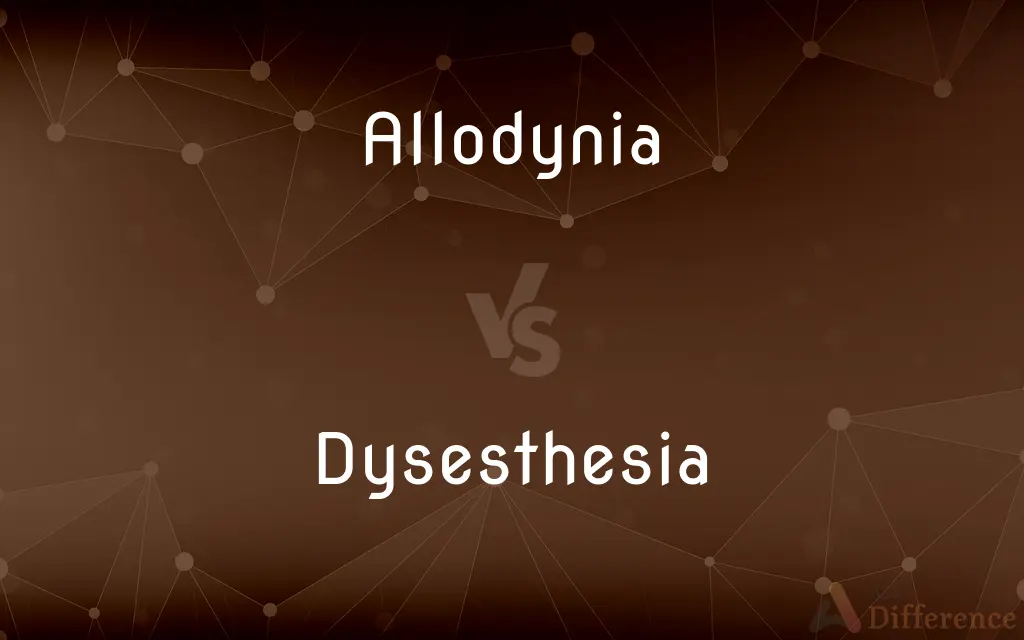Allodynia vs. Dysesthesia — What's the Difference?
By Maham Liaqat & Fiza Rafique — Updated on March 21, 2024
Allodynia involves pain from stimuli that don't usually provoke pain, while dysesthesia is a distorted, often unpleasant sensation when touched.

Difference Between Allodynia and Dysesthesia
Table of Contents
ADVERTISEMENT
Key Differences
Allodynia refers to the experience of pain from stimuli that are normally not painful, such as a light touch or a mild temperature change. On the other hand, dysesthesia involves abnormal and often unpleasant sensations, which may occur without an external stimulus or in response to something that typically doesn't cause such sensations.
Allodynia can manifest in various forms, including mechanical allodynia where touch or pressure triggers pain, while dysesthesia can present as burning, electric shock-like, or itching sensations without an obvious cause.
Patients with allodynia might find daily activities like putting on clothes painful, whereas those with dysesthesia may experience discomfort or pain even without any physical contact or interaction.
The causes of allodynia often relate to underlying nerve damage or a dysfunction in the nervous system, such as seen in conditions like fibromyalgia or postherpetic neuralgia. Conversely, dysesthesia is frequently associated with neurological disorders such as multiple sclerosis or diabetic neuropathy, where there is direct damage to nerves or the central nervous system.
Treatment for allodynia typically focuses on managing the underlying condition and may include medications like topical creams or anticonvulsants, while the management of dysesthesia often involves addressing the nerve damage through medications, physical therapy, or lifestyle changes to reduce discomfort.
ADVERTISEMENT
Comparison Chart
Definition
Pain from non-painful stimuli.
Distorted sensations, often unpleasant.
Typical Sensations
Light touch or mild temperatures causing pain.
Burning, itching, or electric shock-like feelings.
Cause
Often nerve dysfunction or damage.
Usually related to neurological disorders.
Common Conditions
Fibromyalgia, postherpetic neuralgia.
Multiple sclerosis, diabetic neuropathy.
Treatment
Managing underlying condition, topical creams.
Medications, physical therapy, lifestyle changes.
Compare with Definitions
Allodynia
Triggered by Light Touch.
The soft touch of a shirt causing pain.
Dysesthesia
Can Occur Without External Stimulus.
Experiencing sharp pains without being touched.
Allodynia
May Involve Various Types.
Mechanical allodynia where pressure triggers pain.
Dysesthesia
Distorted Sensations.
Feeling burning sensations without a heat source.
Allodynia
Pain from Non-Painful Stimuli.
A gentle breeze causing discomfort on the skin.
Dysesthesia
Often Presents as Burning or Itching.
Unexplained itching sensations on the skin.
Allodynia
Managed by Treating Underlying Conditions.
Using anticonvulsants to reduce sensitivity.
Dysesthesia
Related to Neurological Disorders.
Occurring in conditions like multiple sclerosis.
Allodynia
Often Related to Nerve Dysfunction.
Developing after nerve damage from an injury.
Dysesthesia
Treatment Focuses on Nerve Damage.
Using medications to manage symptoms.
Allodynia
Allodynia is a condition in which pain is caused by a stimulus that does not normally elicit pain. For example, bad sunburn can cause temporary allodynia, and touching sunburned skin, or running cold or warm water over it, can be very painful.
Dysesthesia
Dysesthesia (or dysaesthesia) means "abnormal sensation". Its etymology comes from the Greek word "dys," meaning "not-normal," and "aesthesis," which means "sensation" (abnormal sensation).
Allodynia
Pain produced by innocuous stimulation of normal skin.
Dysesthesia
(medicine) A condition caused by lesions of the nervous system that causes abnormal sensations such as burning, wetness, or itching.
Common Curiosities
What causes dysesthesia?
It's frequently associated with neurological disorders that involve direct nerve damage.
Can allodynia be treated?
Yes, by managing the underlying condition and possibly with medications like topical creams.
Are there different types of allodynia?
Yes, including mechanical allodynia and thermal allodynia, based on the stimulus causing pain.
What is allodynia?
Allodynia is the experience of pain from stimuli that do not normally provoke pain.
How does the treatment of allodynia differ from dysesthesia?
Allodynia treatment often focuses on the condition causing it, while dysesthesia treatment aims to relieve nerve damage symptoms.
What causes allodynia?
It is often caused by nerve damage or dysfunction within the nervous system.
Can allodynia and dysesthesia occur together?
Yes, they can both occur in individuals, often due to underlying neurological conditions.
Is allodynia the same as hypersensitivity?
Allodynia is a type of hypersensitivity, specifically to stimuli that shouldn't normally cause pain.
What is dysesthesia?
Dysesthesia refers to distorted, often unpleasant sensations that may occur without an external stimulus.
What are common treatments for allodynia?
Treatments include managing the primary condition and may involve pain relief medications.
How is dysesthesia managed?
Through medications, physical therapy, or lifestyle changes aimed at reducing discomfort.
What distinguishes dysesthesia from normal sensations?
Dysesthesia is characterized by abnormal sensations, like burning or itching, without a clear cause.
Can dysesthesia be a symptom of multiple sclerosis?
Yes, it is a common symptom in multiple sclerosis due to nerve damage.
What lifestyle changes can help with dysesthesia?
Lifestyle changes can include stress management, avoiding certain triggers, and maintaining a healthy diet.
Is dysesthesia always painful?
While often uncomfortable or painful, dysesthesia can also manifest as non-painful but abnormal sensations.
Share Your Discovery

Previous Comparison
Rock vs. Diamond
Next Comparison
Theme vs. MoralAuthor Spotlight
Written by
Maham LiaqatCo-written by
Fiza RafiqueFiza Rafique is a skilled content writer at AskDifference.com, where she meticulously refines and enhances written pieces. Drawing from her vast editorial expertise, Fiza ensures clarity, accuracy, and precision in every article. Passionate about language, she continually seeks to elevate the quality of content for readers worldwide.














































